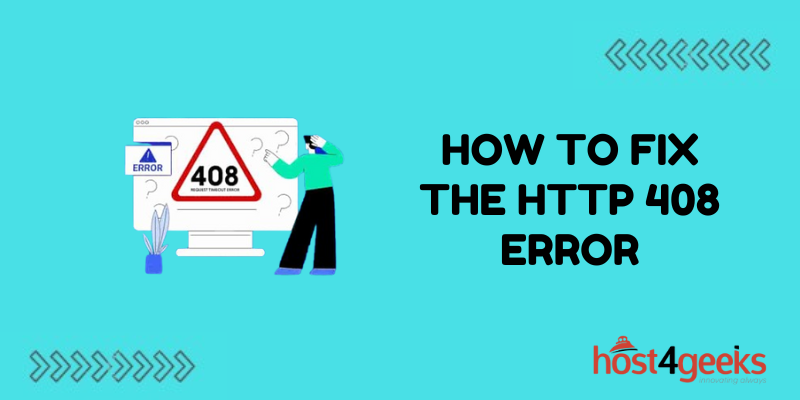Nothing is more frustrating than error messages disrupting your website experience. One of the most common errors website owners face is the HTTP 408 status code, also known as a request timeout error.
You or your users try to load a web page, but are met with delays, failed requests, and disappointment. The server stops waiting after a certain time period passes without completing the request.
While timeouts originate from both server and client-side issues, the end result is an unreliable, slow website. Before you pull your hair out over constant 408 errors, take a deep breath. This error can be prevented and fixed with the right troubleshooting techniques.
In this guide, we’ll explore the various causes of the HTTP 408 status code and actionable solutions you can implement right away. By adjusting configurations, improving connectivity, and optimizing requests, you’ll be able to resolve timeouts and keep your website running smoothly.
What Causes the HTTP 408 Error?
The HTTP 408 error is triggered when the server stops waiting for a request from the client after a set time period. There are a few key reasons why you may encounter this error:
Slow Network
Slow internet connectivity can cause requests to stall and time out. If you or your users are on a poor network, requests may not reach the server fast enough. Slow networks are often the result of distance, network congestion, or hardware-related issues.
Large Requests
Very large requests with abundant data can take a long time to process. If a request contains too much data, the server may time out before receiving it all. This is commonly seen with file uploads or database queries.
Server Overload
An overloaded server may be slow to respond to requests. Too many requests at once can cause queues and delays in processing time. Unexpected traffic spikes can easily overwhelm servers and lead to timeouts.
Server Configuration
Most web servers have timeout thresholds configured. If these are set too low, normal requests may time out unexpectedly. Optimizing timeout settings requires balancing speed and stability.
Client-Side Issues
Sometimes the client may inadvertently delay sending the request. Browser caching, plugins, or computer resources can stall requests over time. The client needs to transmit requests promptly as well.
How to Fix the HTTP 408 Error
Luckily, there are effective solutions for overcoming HTTP 408 errors:
Check Connectivity Issues
Start by testing general connectivity. Change networks, restart devices, or contact your ISP if internet access is slow. For remote servers, check for VPN, firewall, or hostname resolution problems.
Increase Server Timeout
Adjust the request timeout limit on your web server. This gives requests more time to complete before timing out. But don’t set this too high, as it can consume resources for stalled processes.
Optimize Database Queries
Tune database queries that are slow to return results. Add indexes, partitions, or caching to improve response times. For complex data requests, you may need query analysis and optimization.
Implement Caching
Caching stores commonly accessed data in temporary storage for fast retrieval. Page caching, object caching, and CDNs help reduce server workloads and speed up request times.
Load Balancing
Distribute requests across multiple servers. Adding more computing resources allows for simultaneous processing and prevents overload on individual servers.
Check for Resource Constraints
Determine if your server lacks sufficient RAM, disk space, or CPU power. Upgrading to more robust hardware can help better handle demand and prevent timeouts.
Disable Unneeded Plugins
Disable browser extensions and plugins that may interfere with or delay sending requests. Try using alternate browsers as well for comparison testing.
Increase Client Timeout
Like servers, clients also have timeout thresholds in place. Increasing the client timeout may allow more time for successful request completion.
Enable Compression
Compressing large responses like images, files, and scripts reduces transfer times over the network. Gzip compression is universally supported and easy to implement.
Preventing Future 408 Errors
Along with corrective measures, some best practices can help minimize HTTP 408 errors proactively:
- Monitor server performance metrics and log timeout requests to identify issues early.
- Implement request throttling to queue and pace excessive traffic.
- Profile code to isolate slow executing segments, then optimize.
- Set up uptime and load monitoring to get alerts for surges.
- Test timeout settings during peak and maintenance windows.
- Check for timeout handling in code to retry failed requests.
- Enable request compression to reduce transfer times.
- Regularly test site speed and performance from diverse networks.
In Closing
The HTTP 408 timeout error doesn’t have to be frustrating once you know how to properly resolve it. With a few targeted improvements, you can optimize both server and client to transmit requests reliably within the allotted time frame. Adjusting configurations, enhancing caching, and upgrading hardware are all effective solutions for keeping your website running smoothly.

